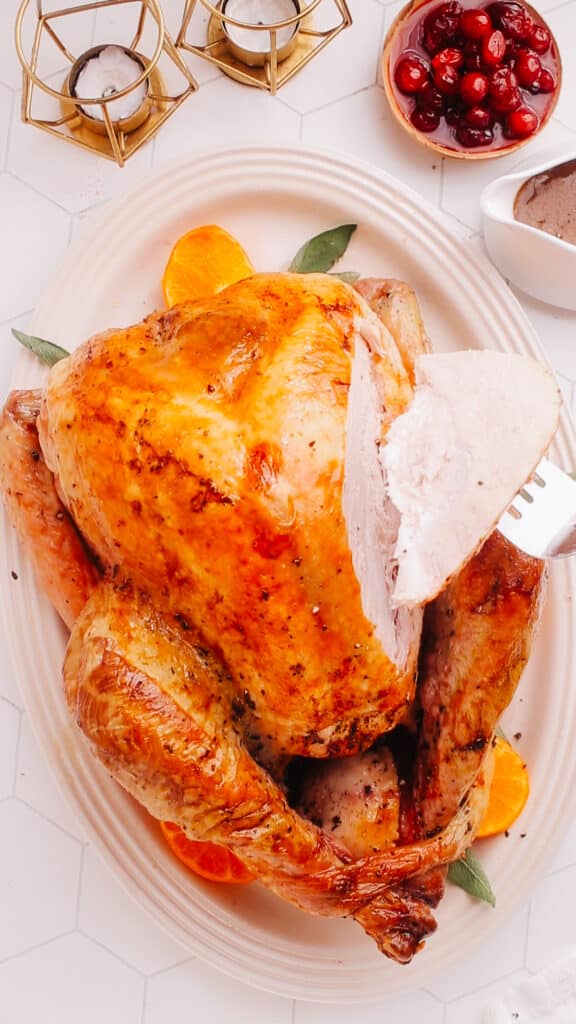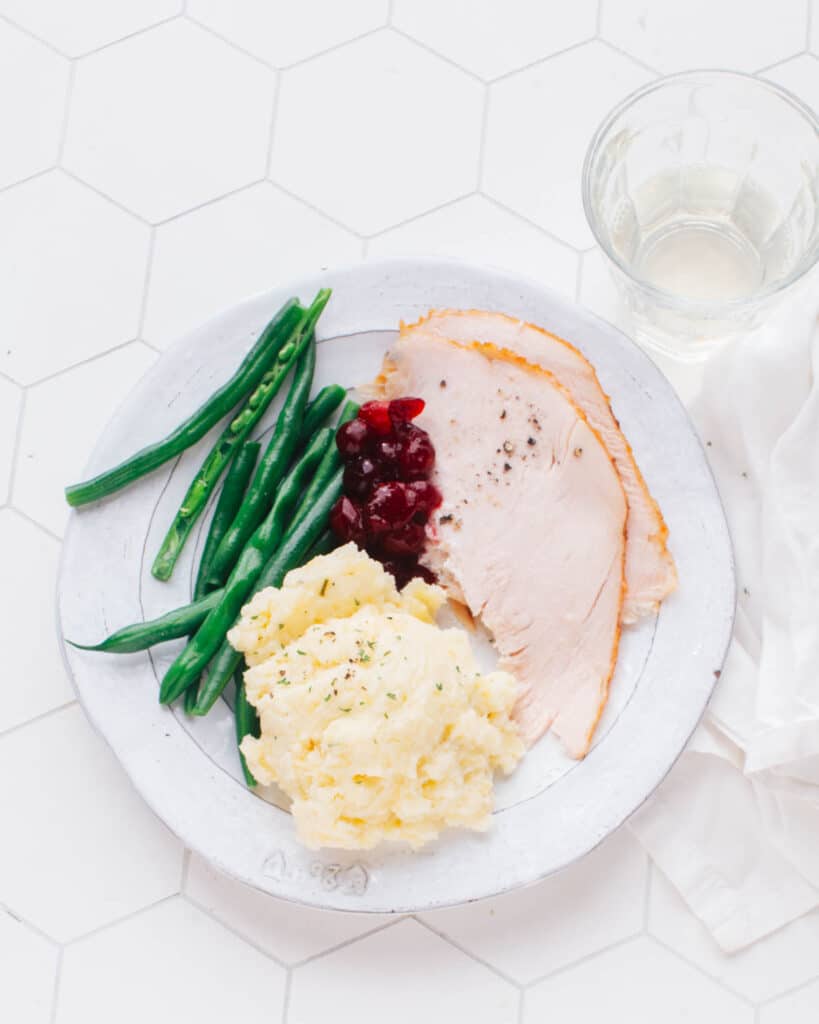This super easy turkey recipe is no brine, no baste, and no stress. So easy and delicious. Want to know how to cook a turkey to juicy, moist perfection with no stress?.
A perfectly roasted turkey is the focal point of Thanksgiving, Christmas, or any other special occasion. It is a culinary masterpiece that exudes coziness, warmth, and joyous celebration. However, getting that caramelized brown exterior and tender, flavorful meat can seem difficult, particularly for inexperienced chefs. Fear not, wannabe cooks! This in-depth manual will provide you with all the skills and information required to roast a turkey without stuffing like a seasoned pro.
Understanding the Basics: Key Ingredients and Equipment
Before embarking on this culinary adventure, let’s gather the essential ingredients and equipment:
Ingredients:
- Turkey: Opt for a fresh or thawed turkey, preferably free-range or organic for superior quality and flavor. Choose a size that accommodates your guest count, typically 1.5 pounds per person.
- Salt and pepper: Seasoning staples that enhance the natural flavor of the turkey.
- Butter: Melted butter adds richness and promotes browning of the skin.
- Fresh herbs (optional): Rosemary, thyme, sage, or a combination of your favorites can infuse the turkey with aromatic notes.
- Vegetables (optional): Carrots, celery, and onions create a flavorful base for the turkey to rest on, adding depth to the drippings.
Equipment:
- Roasting pan: Choose a sturdy pan large enough to accommodate the turkey comfortably. Disposable aluminum pans are a convenient option, while a roasting rack elevates the turkey for even browning.
- Meat thermometer: An indispensable tool for ensuring the turkey reaches a safe internal temperature of 165°F throughout.
- Basting brush (optional): Distributes melted butter evenly over the turkey skin for optimal browning.
- Aluminum foil: Used to tent the turkey during roasting to prevent overbrowning.
Step-by-Step Guide to Roasting Perfection
With the ingredients and equipment at hand. let’s delve into the step-by-step process:
1. Preparation:
- Thaw the turkey thoroughly: If using a frozen turkey, thaw it in the refrigerator for 24 hours per 5 pounds of weight. Alternatively, immerse the turkey in cold water, changing the water every 30 minutes, for a quicker thaw.
- Remove giblets and neck: Locate the giblets and neck, typically found in the turkey’s cavity, and discard them or reserve them for gravy.
- Pat the turkey dry: Use paper towels to thoroughly dry the turkey’s skin, ensuring even browning.
- Season generously: Season the inside and outside of the turkey with salt and pepper to taste.
- Stuffing (optional): If using stuffing, loosely fill the neck and body cavities, ensuring it doesn’t pack tightly. Remember, stuffing the turkey can prolong cooking time.
2. Roasting:
- Preheat oven to 325°F: Ensure the oven is at the correct temperature before placing the turkey inside.
- Position the turkey: Place the turkey, breast-side up, on a roasting rack in the pan. If using vegetables, arrange them around the turkey.
- Baste with butter (optional): Brush the turkey skin with melted butter for added richness and browning.
- Roast uncovered: Roast the turkey uncovered for the initial 20-22 minutes per pound. If the turkey weighs more than 16 pounds, reduce the roasting time to 18-20 minutes per pound.
- Baste periodically: Every 30-45 minutes, baste the turkey with the pan drippings or additional melted butter. If the skin starts to brown too quickly, loosely tent the turkey with foil or cover the breast with butter-soaked cheesecloth.
- Monitor internal temperature: Use a meat thermometer to check the turkey’s internal temperature in the thickest part of the thigh. The temperature should reach 165°F for safe consumption.
3. Resting and Carving:
- Rest the turkey: Once the turkey reaches the desired temperature, remove it from the oven and let it rest for 20 minutes at room temperature. This allows the juices to redistribute, resulting in a more tender and flavorful turkey.
- Carve the turkey: Carve the turkey using a sharp knife and a carving fork. Start by separating the legs and wings, then slice the breast meat into thin slices.
Tips and Tricks for a Flawless Roast
- Brining (optional): Brining the turkey in a salt-water solution for 12-24 hours can enhance its moisture and flavor. However, high-quality turkeys may not require brining.
- Flavorful additions: Experiment with different herbs, spices, or citrus zest to infuse the turkey with unique flavor profiles.
- Prevent overbrowning: If the turkey starts to brown too quickly, tent it loosely with foil or cover the breast with butter-soaked cheesecloth.
- Use a roasting rack: Elevating the turkey on a roasting rack allows for even heat distribution and crispy skin.
- Basting frequency: Baste the turkey every 30-45 minutes for optimal browning and moisture.
- Resting is crucial: Allow the turkey to rest for at least 20 minutes before carving to ensure juicy and flavorful meat.
FAQs: Addressing Common Turkey Roasting Concerns
1, How long should I roast the turkey?
The roasting time depends on the turkey’s weight. For turkeys under 16 pounds, roast for 20 to 22 minutes per pound, and for larger turkeys, roast for 18 to 20 minutes per pound.
2. Do I need to baste the turkey?
Basting is not essential but helps keep the skin moist and promotes browning. Baste every 30-45 minutes with pan drippings or melted butter.
3. Should I stuff the turkey?
Stuffing the turkey can prolong cooking time and potentially dry out the meat. Consider cooking stuffing separately or using a stuffingless recipe.
4. How do I know when the turkey is done?
Use a meat thermometer to check the internal temperature in the thickest part of the thigh. The temperature should reach 165°F for safe consumption.
5. How do I prevent the turkey from drying out?
Brining (optional), basting, and resting the turkey are crucial steps to prevent dryness. Additionally, avoid overcooking the turkey.
Additional Resources: Expanding Your Culinary Horizons
- Easy, No-Fuss Thanksgiving Turkey: https://tastesbetterfromscratch.com/easy-no-fuss-thanksgiving-turkey/
- Roasted Turkey, No Stuffing: https://www.latimes.com/recipe/roasted-turkey-no-stuffing
Roasting a turkey without stuffing is an achievable and rewarding culinary endeavor. By following these detailed instructions, tips, and addressing common concerns, you can confidently create a golden-brown, succulent, and flavorful turkey that will impress your guests and become a cherished tradition. Remember, patience, attention to detail, and a touch of culinary creativity are the key ingredients to roasting a turkey without stuffing that will leave everyone asking for seconds.
How to check for doneness
I suggest taking most roasts out of the oven when their internal temperature is lower than desired. This is because of carryover cooking, which means the temperature continues to rise as the meat sits.
I don’t do this for turkey, however.
A turkey roast is so large that there are inevitably parts that are higher and lower in temperature. I like to cook the turkey to the recommended temperature of 165ºF just to be safe and prevent the spread of salmonella.
Insert your cooking thermometer into many parts of the bird. That’s how to cook a turkey fully without concern for food safety. I test the temperature of:
- the thickest part of the thigh
- in the bottom of the bird under the leg
- in the thickest part of the breast
- in around the wing
- and a few more spots for good measure

How to cook a turkey
Cooking a turkey can be intimidating not only for a beginner chef but also for an experienced home cook who has never worked with such a large and intimidating dish.
Happily, it is actually really easy. The two main things to aim for are:
- Don’t overcook it.
- Don’t undercook it.
We’re not reaching for the stars, here!
In order to achieve this:
- Grab a cooking thermometer. (It was sixteen dollars, and I’ve had good use out of it for years.) I cannot emphasize enough how important this tool is.
- To further simplify, buy fresh. I find it juicier and easier to manage planning-wise. This means deciding to buy one up to five days in advance. Consider placing an order with your butcher or grocery store because they often sell out.
- If you decide to buy frozen turkey, make sure it has completely thawed before cooking; this could need a few days in the fridge, so give yourself plenty of time. Nothing like a semi-frozen thigh to ensure an over-cooked breast.
- Cook at a low oven temperature. I’ve experimented with a few methods that suggest starting at 400ºF or higher and then decreasing the heat. This expedites the cooking process, but it also raises the risk of drying out the parts of the bird—like the lean breast meat—that are in direct contact with the heat.

